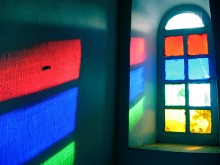And what would it mean, to see colors no one else can?
I recently listened to a fascinating Radiolab episode all about color. I was particularly struck by the section on tetrachromacy, which is the possibility that there are superhumans among us who can see more colors than the rest of us.
As you may remember from biology class, we get color vision thanks to the cone cells in our eyes. Humans are trichromats, meaning that we have three types of cone cells: red, green, and blue. These cells allow us to see all the colors that we do. They respond to light within a particular section of the spectrum.
Other animals have more types of cone cells. Many birds and insects, for example, have a fourth type of cone which allows them to see ultraviolet. Other animals have even more cones, and can see an even wider spectrum. (Some animals have fewer - like dogs, who have only two kinds of cone cells, and can only see blue and yellow.)
But as with everything biological, there is always an exception to the rule. In this case, the exception is - so far - mostly hypothetical. In theory, there could be people with a mutation that allows a fourth type of cone cell. For genetic reasons, these people would almost certainly be female. And more likely to be women who have men in their family who have red-green color blindness.
A DNA blood test would show if this person had the right genetic characteristics to be a tetrachromat. In the Radiolab episode they managed to find and interview one of the two people in the world who is known to have tetrachromacy. But their tests were inconclusive in a fascinating way: a trained artist (a landscape painter) who does NOT have tetrachromacy was also able to pass the same color recognition tests.
It seems that, from a practical standpoint, it is quite possible to improve your "color IQ" just by training your eye, over the year, to recognize and discern differences in color.
I had an experience with this recently, myself. I was at a yarn store picking out balls of yarn. I picked out four balls of what I thought were the same shade of red. But the store clerk quickly noted that one of them was not like the other: I had actually chosen two different colors. When she pointed it out, I could see the difference, but only just barely. Clearly she had a much more highly-trained eye, when it came to yarn colors!
